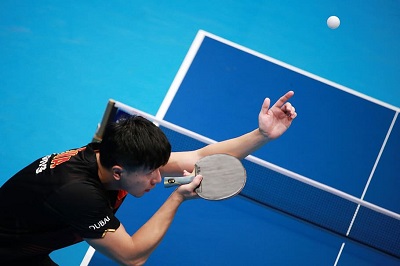Comparison of hip joint mechanical energetics in table tennis forehand and backhand drives
a preliminary study
Abstract
Hip joints are highly involved in table tennis. Some authors found both pelvic angular velocity and hip joint torques are related to the racket velocity. Others have also demonstrated how some of the best players have higher ranges of motion of the lower-limb joints. Therefore, the mechanical work generated by the playing-side-hip can be seen as indicator of the playing intensity associated with different strokes. The aim of this study was to quantify the hip joint mechanical work and power during four classical strokes. Motion capture acquisitions were performed on two international players. A biplanar radiographic acquisition was also performed to personalize the biomechanical model. Hip joint velocity and torques were calculated on the dominant side, allowing mechanical power and work to be calculated between the end of backswing and the ball impact. The highest level of mechanical work from the hip joint was found for forehand drive against backspin and forehand topspin drive with pivot. A backhand drive required the lowest hip mechanical work, and the forehand drive against topspin was found to be intermediate. The lower work required from the backhand stroke makes it suitable as a waiting stroke.
References
Bańkosz, Z., & Winiarski, S. (2018). The evaluation of changes of angles in selected joints during topspin forehand in table tennis. Motor Control, 22(3), 314–337. https://doi.org/10.1123/mc.2017-0057
Bourgain, M., Hybois, S., Thoreux, P., Rouillon, O., Rouch, P., & Sauret, C. (2018). Effect of shoulder model complexity in upper-body kinematics analysis of the golf swing. Journal of Biomechanics, 75, 154–158. https://doi.org/10.1016/j.jbiomech.2018.04.025
Delp, S. L., Anderson, F. C., Arnold, A. S., Loan, P., Habib, A., John, C. T., … Thelen, D. G. (2007). OpenSim : Open-Source Software to Create and Analyze Dynamic Simulations of Movement. IEEE Transactions on Biomedical Engineering, 54(11), 1940–1950.
Hendricks, S., Karpul, D., & Lambert, M. (2014). Momentum and kinetic energy before the tackle in rugby union. Journal of Sports Science and Medicine, 13(3), 557–563.
Huang, H., Hsueh, Y., Chen, Y., Chang, T., Pan, K., Huang, K., & Tsai, C.-L. (2013). The kinematics analysis of table tennis forehand and backhand drives. In XXIV Congress of the international society of biomechanics (pp. 3–6).
Iino, Y. (2017). Hip joint kinetics in the table tennis topspin forehand: relationship to racket velocity. Journal of Sports Sciences, 36(7), 1–9. https://doi.org/10.1080/02640414.2017.1344777
Iino, Y., & Kojima, T. (2009). Kinematics of table tennis topspin forehands: Effects of performance level and ball spin. Journal of Sports Sciences, 27(12), 1311–1321. https://doi.org/10.1080/02640410903264458
Iino, Y., & Kojima, T. (2011). Kinetics of the upper limb during table tennis topspin forehands in advanced and intermediate players. Sports Biomechanics, 10(4), 361–377. https://doi.org/10.1080/14763141.2011.629304
Iino, Y., & Kojima, T. (2016). Effect of the racket mass and the rate of strokes on kinematics and kinetics in the table tennis topspin backhand. Journal of Sports Sciences, 34(8), 721–729. https://doi.org/10.1080/02640414.2015.1069377
Lu, T. W., & O’Connor, J. J. (1999). Bone position estimation from skin marker co-ordinates using global optimisation with joint constraints. Journal of Biomechanics, 32(2), 129–134. https://doi.org/10.1016/S0021-9290(98)00158-4
Malagoli Lanzoni, I., Di Michele, R., & Merni, F. (2014). A notational analysis of shot characteristics in top-level table tennis players. European Journal of Sport Science, 14(4), 309–317. https://doi.org/10.1080/17461391.2013.819382
Martin, C., Bideau, B., Bideau, N., Nicolas, G., Delamarche, P., & Kulpa, R. (2014). Energy flow analysis during the tennis serve: Comparison between injured and noninjured tennis players. American Journal of Sports Medicine, 42(11), 2751–2760. https://doi.org/10.1177/0363546514547173
Qian, J., Zhang, Y., Baker, J. S., & Gu, Y. (2016). Effects of performance level on lower limb kinematics during table tennis forehand loop. Acta of Bioengineering and Biomechanics, 18(3), 149–155. https://doi.org/10.5277/ABB-00492-2015-03
Raabe, M. E., & Chaudhari, A. M. W. (2016). An investigation of jogging biomechanics using the fullbody lumbar spine model: Model development and validation. Journal of Biomechanics, 49(7), 1238–1243. https://doi.org/10.1016/j.jbiomech.2016.02.046
Rasmussen, J., Kwan, M. M. S., Andersen, M. S., & de Zee, M. (2010). Analysis of segment energy transfer using musculoskeletal models in a high speed badminton stroke. In Proceedings of the 9th International Symposium on Computer Methods in Biomechanics and Biomedical Engineering, CMBBE2010. Cardiff University.
Seth, A., Matias, R., Veloso, A. P., & Delp, S. L. (2016). A biomechanical model of the scapulothoracic joint to accurately capture scapular kinematics during shoulder movements. PLoS ONE, 11(1), 1–18. https://doi.org/10.1371/journal.pone.0141028
Van der Kruk, E., van der Helm, F. C. T., Veeger, H. E. J., & Schwab, A. L. (2018). Power in sports: A literature review on the application, assumptions, and terminology of mechanical power in sport research. Journal of Biomechanics, 79, 1–14. https://doi.org/10.1016/j.jbiomech.2018.08.031
Wu, G., & Cavanagh, P. R. (1995). ISB Recommendations in the Reporting for Standardization of Kinematic Data. Journal of Biomechanics, 28(10), 1257–1261. https://doi.org/10.1016/0021-9290(95)00017-C
Wu, G., Siegler, S., Allard, P., Kirtley, C., Leardini, A., Rosenbaum, D., … Stokes, I. (2002). ISB recommendation on definitions of joint coordinate system of various joints for the reporting of human joint motion—part I: ankle, hip, and spine. Journal of Biomechanics, 35(4), 543–548. https://doi.org/10.1016/S0021-9290(01)00222-6
Wu, G., Van Der Helm, F. C. T., Veeger, H. E. J., Makhsous, M., Van Roy, P., Anglin, C., … Buchholz, B. (2005). ISB recommendation on definitions of joint coordinate systems of various joints for the reporting of human joint motion - Part II: Shoulder, elbow, wrist and hand. Journal of Biomechanics, 38(5), 981–992. https://doi.org/10.1016/j.jbiomech.2004.05.042










_(1).png)
